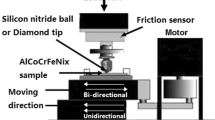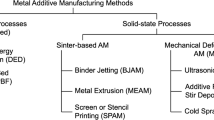Abstract
Solid particle erosion is identified as a major wear process occurring in numerous industrial applications. A number of test parameters influence the behavior of the materials during this wear process. Particle shape is one of the key factors, which is often discussed for ductile or brittle materials in the literature, but a comparative study of ductile and brittle materials showing an effect of particle shape has not been addressed in detail until now. The present work discusses the influence of erodent shape on the wear behavior of a ductile (Ti-6Al-4 V alloy) and a brittle (TiN coating) material during the erosion process. Investigations are performed in an erosion test rig where the ductile and brittle materials are charged with spherical and angular SiO2 particles at normal impact. Results show an inverse erosion behavior of ductile and brittle materials with the variation in particle shape. Ductile materials show low material removal with spherical particles, whereas brittle materials show low material removal rates with angular ones. This work also provides an analysis of the material removal phenomenon to understand the effect of particle shape on tested materials. Since materials removal phenomenon in ductile materials is often reported in the literature, this work addresses the material removal behavior especially in ceramic coatings.








Similar content being viewed by others
References
Naveed, M.: Study of crystallography and erosion behavior of single and multilayer coatings used for applications in aero engines. Doctorate, Brandenburg Technical University (2015)
Naveed, M., Renteria, A.F., Nebel, D., Weiß, S.: Study of high velocity solid particle erosion behaviour of Ti2AlC MAX phase coatings. Wear 342–343, 391–397 (2015)
Tilly, G.P.: Erosion caused by impact of solid particles. Treatise Mater. Sci. Technol. 13, 287–319 (1979)
Tilly, G.P., Sage, W.: The interaction of particle and material behaviour in erosion processes. Wear 16(6), 447–465 (1970)
Winter, R.E., Hutchings, I.M.: Solid particle erosion studies using single angular particles. Wear 29(2), 181–194 (1974)
Cousens, A., Hutchings, I.: A critical study of the erosion of an aluminium alloy by solid spherical particles at normal impingement. Wear 88(3), 335–348 (1983)
Brown, R., Kosco, S., Jun, E.: The effect of particle shape and size on erosion ofaluminum alloy 1100 at 90° impact angles. Wear 88(2), 181–193 (1983)
Srinivasan, S., Scattergood, R.O.: Effect of erodent hardness on erosion of brittle materials. Wear 128(2), 139–152 (1988)
Murugesh, L., Scattergood, R.O.: Effect of indentation load on fragmentation of erosion particle tips. Wear 140, 115–124 (1990)
Bousser, E.: Solid particle erosion mechanisms of protective coatings for aerospace application. PhD, Ecole Polytechnic Montreal (2013)
Wada, S.: Effects of hardness and fracture toughness of target materials and impact particles on erosion of ceramic materials. Key Eng. Mater. 71, 51–74 (1992)
Liebhard, M., Levy, A.: The effect of erosdent particle characteristics on the erosion of metals. Wear 151(2), 381–390 (1991)
Palasamudram, S.L., Bahadur, S.: Particle characterization for angularity and the effects of particle size and angularity on erosion in a fluidized bed environment. Wear 203, 455–463 (1997)
Stachowiak, G.W.: Particle angularity and its relationship to abrasive and erosive wear. Wear 241(2), 214–219 (2000)
Bahadur, S., Badruddin, R.: Erodent particle characterization and the effect of particle size and shape on erosion. Wear 138(1), 189–208 (1990)
Sundararajan, G.: A comprehensive model for the solid particle erosion of ductile materials. Wear 149, 111–127 (1991)
Finnie, I.: Erosion of surfaces by solid particles. Wear 3, 253–258 (1960)
Chen, D., Sarumi, M., Al-Hassani, S., Gan, S., Yin, Z.: A model for erosion at normal impact. Wear 205(1), 32–39 (1997)
Hutchings, I.: A model for the erosion of metals by spherical particles at normal incidence. Wear 70(3), 269–281 (1981)
Hutchings, I.: Strain rate effects in microparticle impact. J. Phys. D Appl. Phys. 10(14), L179 (1977)
Lindholm, U.: Review of dynamic testing techniques and material behavior. In: Conference on Mechanical Properties of Materials at High Rates of Strain, Oxford, UK, 2 Apr 1974, pp. 3–21. American Inst. of Physics, New York (1974)
Wheeler, D.W., Wood, R.J.K.: Fracture of diamond coatings by high velocity sand erosion. Philos. Mag. 89(3), 285–310 (2009)
Chai, H.: Fracture mechanics analysis of thin coatings under spherical indentation. Int. J. Fract. 119, 263 (2003)
Chen, X., Hutchinson, J.W., Evans, A.G.: The mechanics of indentation induced lateral cracking. J. Am. Ceram. Soc. 88(5), 1233–1238 (2005)
Naveed, M.: Investigation of the wear resistance properties of Cr/CrN multilayer coatings against sand erosion. Paper presented at the European Symposium on Friction, Wear, and Wear Protection, Karlsruhe
Hutchings, I.M.: Ductile-brittle transitions and wear maps for the erosion and abrasion of brittle materials. J. Phys. D Appl. Phys. 25(1A), A212 (1992)
Hutchings, I.: Transitions, threshold effects and erosion maps. In: Key Engineering Materials, pp. 75–92. Trans Tech Publications, Switzerland (1992)
Author information
Authors and Affiliations
Corresponding author
Rights and permissions
About this article
Cite this article
Naveed, M., Schlag, H., König, F. et al. Influence of the Erodent Shape on the Erosion Behavior of Ductile and Brittle Materials. Tribol Lett 65, 18 (2017). https://doi.org/10.1007/s11249-016-0800-x
Received:
Accepted:
Published:
DOI: https://doi.org/10.1007/s11249-016-0800-x




